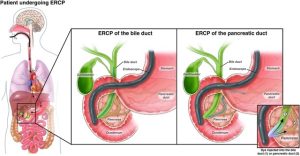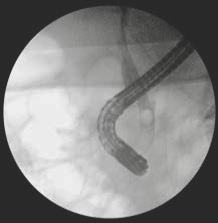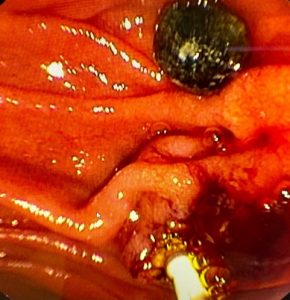ERCP ( Endoscopic Retrograde Cholangio-Pancreatography)
What is an ERCP?
ERCP is a specialized procedure that combines the use of a side-viewing endoscope (a thin, flexible tube with a light and camera) called a Duodenoscope and X-rays to examine and treat conditions affecting the bile ducts and pancreatic ducts. These are the drainage tubes from your liver, gallbladder, and pancreas that lead into the first part of your small intestine (duodenum).
 During ERCP, the endoscope is passed through your mouth, down your oesophagus (food pipe), through your stomach, and into the duodenum. A small plastic tube (catheter) is then passed through the endoscope into the openings of the bile and pancreatic ducts. A special dye (contrast medium) is injected into these ducts, which makes them visible on X-rays. This allows the George to see and treat abnormalities.
During ERCP, the endoscope is passed through your mouth, down your oesophagus (food pipe), through your stomach, and into the duodenum. A small plastic tube (catheter) is then passed through the endoscope into the openings of the bile and pancreatic ducts. A special dye (contrast medium) is injected into these ducts, which makes them visible on X-rays. This allows the George to see and treat abnormalities.
Why is an ERCP Performed?
ERCP is often performed for both diagnostic and therapeutic reasons. Common reasons for needing an ERCP are:
- Identify and remove gallstones that are stuck in the bile duct.
- Investigate and treat blockages or narrowing (strictures) in the bile or pancreatic ducts, which may be caused by stones, tumours (cancerous or non-cancerous), infection, or scarring.
- Place stents (small plastic or metal tubes) to keep a narrowed or blocked duct open and allow bile or pancreatic juice to drain.
- Take tissue samples (biopsies) or brushings from the ducts for examination under a microscope to diagnose conditions like cancer.
- Dilate (stretch) narrowed ducts.
- Investigate causes of pancreatitis (inflammation of the pancreas) or unexplained jaundice (yellowing of the skin and eyes).
- Drain fluid collections in or around the pancreas.
- Perform a sphincterotomy, which involves making a small cut in the muscle (sphincter of Oddi) that controls the opening of the bile and pancreatic ducts into the intestine. This can help with drainage or allow access for other treatments like stone removal.


Large gallstone removed from the bile duct at ERCP
Patients frequently present in emergency situations, either as post operative complications from Gallbladder surgery, with Pancreatitis, or bile duct infections requiring urgent intervention and stent placement. As this procedure is complex, high risk and requires extensive training George is one of the very few Surgeons ( the only one in Geelong) that performs this rare subspecialised procedure. He provides a high quality service, caring for large number of patients not only from Geelong but an area stretching from Warrnambool to Werribee. You will often be referred directly to or transferred in hospital to George by your GP, Emergency Physician or Specialist when it is necessary for you to have this procedure.
